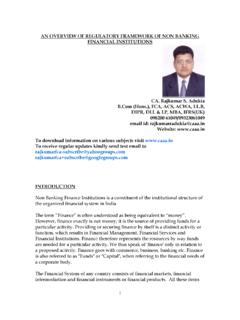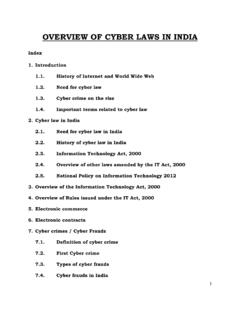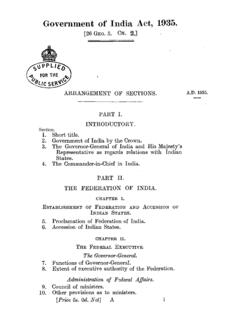Transcription of MEDIA LAWS OF INDIA - caaa.in
1 1 MEDIA laws OF INDIA CA Rajkumar S. Adukia B. Com. (Hons.), FCA, ACS, AICWA, , (UK), MBA, DIPR, DLL&LP Mobile +91 98200 61049/+91 93230 61049 Fax +91 22 26765579 Email 2 Index 1. Introduction 2. MEDIA industry 3. History of MEDIA laws in INDIA 4. MEDIA laws of INDIA an overview 5. laws applicable for Information 6. laws applicable for broadcasting 7. laws applicable for Films 8. Other laws applicable to MEDIA FDI in MEDIA sector Labour related legislations IPR Telegraph Act & Wireless Telegraphy Act 9. Authorities regulating the MEDIA industry 10. Case laws 11. Professional opportunities in the MEDIA industry 12.
2 Useful websites 13. About the Author 3 1. INTRODUCTION One of the objects of a newspaper is to understand the popular feeling and give expression to it, another is to arouse among the people certain desirable sentiments, and the third is the fearlessness to expose popular defects. Mahatma Gandhi Communication is the procedure, which we use to exchange information by various methods and MEDIA is the medium or instrument of storing or communicating information. MEDIA the popular term inter-alia used as Press denotes the print & electronic information carriers the News Papers & Magazines, Radio, Television and currently includes Internet as new MEDIA .
3 Hailed as the Fourth Estate , MEDIA is the watchdog of the public affairs, informing the society and vice versa, acts as the forum to advocate the views of the society at large to those at the helm of public affairs. The word medium comes from the Latin word medius (middle). The word communication is derived from the Latin root communicate. MEDIA law covers an area of law which involves MEDIA of all types (TV, film, music, publishing, advertising, internet & new MEDIA , etc.), and stretches over various legal fields, including but not limited to corporate, finance, intellectual property, publicity and privacy.
4 MEDIA law is a legal field that refers to the following: Advertising broadcasting Censorship Confidentiality Contempt Copyright 4 Corporate law Defamation Entertainment Freedom of information Internet Information technology Privacy Telecommunications 5 2. MEDIA industry According to a recent news, Indian MEDIA & Entertainment industry is to touch ,457 billion by 2016. In 2011, the Indian MEDIA & Entertainment (M&E) industry registered a growth of 12 percent over 2010, to reach INR 728 billon. The growth trajectory is backed by strong consumption in Tier 2 and 3 cities, continued growth of regional MEDIA , and fast increasing new MEDIA business.
5 Overall, the industry is expected to register a CAGR of 15% to touch INR 1,457 billion by 2016. While television continues to be the dominant medium, sectors such as animation & VFX, digital advertising, and gaming are fast increasing their share in the overall pie. Radio is expected to display a healthy growth rate after the advent of Phase 3. Print, while witnessing a decline in growth rate, will continue to be the second largest medium in the Indian M&E industry . Also, the film industry had a reason to cheer, with multiple movies crossing the INR 100 crore mark in domestic theatrical collections, and INR 30 crore mark in C&S rights.
6 Advertising spends across all MEDIA accounted for INR 300 billion in 2011, contributing to 41 percent of the overall M&E industry s revenues. Advertising revenues witnessed a growth of 13 percent in 2011, as against 17 percent observed in 2010. In terms of performance, 2011 proved to be a year with mixed results in terms of growth across different sub sectors. The traditional MEDIA businesses experienced a slow down compared to last year, especially in the second half of the year. However, the new MEDIA segments like Animation and VFX, Online and Gaming businesses witnessed phenomenal growth rates. The MEDIA industry in 2011 in a nutshell Print: The print industry grew by percent from INR 193 billion in 2010 to INR 209 billion in 2011.
7 The growth was slightly lower than the expectation of 6 percent last year due to the challenging macroeconomic environment and reduced advertising spends. Television: The over-all television industry is estimated to be INR 329 billion in 2011, and is expected to grow at a CAGR of 17 percent over 2011-16, to reach INR 735 billion in 2016. The share of subscription to the total industry revenue is expected to increase from 65 percent in 2011 to 69 percent in 2016. The TV industry continues to have headroom for further growth as television penetration in INDIA is still at approximately 60% of total households. Films: With several high budget Hindi releases lined up across the year, 2012 is expected to sustain the growth momentum witnessed in 2011.
8 The Indian film industry is projected to grow at a CAGR of percent to touch INR 150 Billion in 2016. The industry is estimated to be INR 93 billion in 2011 indicating a growth of percent vis- -vis 2010. Music: While 2010 was the year of structural shift from physical formats to digital ones, 2011 provided users viable options of music consumption through different digital platforms. The Indian music industry achieved revenues of INR 9 billion in 2011, registering a growth of 5% over 2010. Radio: Overall the industry grew at 15 percent in CY 2011 to reach INR billion compared to INR 10 billion in CY 2010.
9 New MEDIA : Digital advertising is expected to grow at a CAGR of 30% from 2011-16; digital ads spend reached approximately 4 percent of total M&E industry advertising revenue in 2011. Growth is largely driven by increase in internet penetration and proliferation of new age devices. Animation & VFX: Animation, VFX (visual effects) and Post Production industry achieved estimated revenues of INR 31 billion in 2011, a robust growth of 31 percent over 2010. Growth was achieved on the back of increased contract work, higher VFX content in movies, 2D/3D conversion projects. 7 3. HISTORY OF MEDIA laws IN INDIA When Europeans write on the history of the MEDIA , they refer to the Acta diurna of the Roman Empire as closely akin to the newspaper of today.
10 In INDIA the Rock Edicts of Emperor Ashok ( BC) engraved on the rocks contain in abundance measures adopted and regulations issued by him. This is not very different from the news content of modern MEDIA . In that era when Ashok, the Great, used this technology for communicating his message throughout his vast empire, there is no reference to restrictions on communication imposed by law. However, the Arthashastra written originally in the reign of Chandragupta Maurya (c. 324-300 BC) by Kautilya mentions punishment for spreading false rumours. The Arthashastra and the Rock Edicts also speak of spies and reporters.










